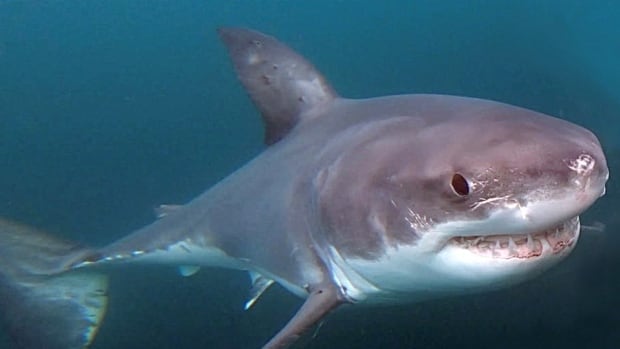[ad_1]
A new business that offers tourists the chance to cage dive with great white sharks off the coast of Nova Scotia aims to combine research with the thrill of getting up close and personal with one of the planet’s most fascinating fishes.
Atlantic Shark Expeditions will run daily trips from the marina in Brooklyn, N.S., outside Liverpool, from Aug. 1 to the end of October. Customers will pay $395 each to go on the daylong trips, and can choose to view sharks from the boat or from a cage, where they will wear a wetsuit and use a snorkel.
Heading up the operation is Neil Hammerschlag, a marine biologist who has worked with and studied sharks for over 25 years in South Africa, the Galapagos, the Bahamas and Florida.
“I’m really excited,” he says. “I’m hoping Nova Scotians will get behind this and get really excited, be proud of the sharks that we have here. I mean, Nova Scotia is known as Canada’s ocean playground. I really hope people take advantage of that ocean playground.”
Great white sharks are known to visit the waters off Nova Scotia, and tagging efforts in recent years have brought more attention to their presence.
In addition to helping tourists tick an item off their bucket lists, Hammerschlag will be using the expeditions to research how great whites are influenced by human activity and climate change, and to learn more about how their population is changing over time and what the animals are doing in Nova Scotia.
He plans to tag sharks, build up an identification database, take biopsies for ecotoxicology studies and conduct ultrasounds on the animals as they swim.
“We’re really trying to solve the mysteries of white sharks off of Nova Scotia,” he says. “Globally, they’re endangered and this might be like a remaining stronghold for those animals, so it’s really important to figure out what makes them tick so we can make sure we can protect that to support their recovery.”
Hammerschlag says sightings during expeditions are not guaranteed, but customers will have the opportunity to spot other sea life such as seals, fish and birds.
“Part of these expeditions is the adventure of the exploration. It’s not an aquarium. It’s not a zoo. This is the wild, and the wild is completely unpredictable.”
Staff will use bait to lure sharks close enough to the boat to interact with them. Hammerschlag says they will not use chum — buckets filled with blood, bone and ground fish — but rather larger pieces of bait, such as tuna heads.
Surfers concerned
That idea doesn’t sit well with some people.
Walter Flower has surfed the waters off Nova Scotia for more than 30 years, and has owned the South Shore Surf and Board Shop outside Lunenburg for about 20 years. He also runs a whale-watching business and has worked with shark researchers for the past few years.

Flower says surfers are concerned about the company’s plan.
“Having sharks associate food with human presence, you know, you get the vibrations of the boat and the splashing around of people in the water … I don’t think it’s a good thing,” he says.
“As they say, don’t feed the bears. If you don’t want to have problems with them, don’t feed them and they won’t come looking.”

Flower says hundreds of surfers frequent the waters of the South Shore, and many are questioning how the plan could affect them.
“We are 100 per cent, you know, the most people at risk.… We look like an injured seal out there in the water. You know, on your best day, you’re in a wetsuit and flailing around out there, you know, and splashing.”
Flower’s brother, Bill Flower, is a commercial fisherman with a degree in marine biology who uses a cage to assist documentary producers and shark researchers.

He shares his brother’s concerns about the safety of surfers, and also worries about the safety of tourists, who must be able to clamber in and out of the cage “with the animals nipping around your ankles.”
“It’s not for the faint of heart,” he says. “It’s safe for professionals like us to do. It’s a calculated risk.… For an inexperienced person to do that, they’re going to be flopping and floundering on the top of the cage. They could have their feet over the side, their legs in the water — probably not a good idea.”
Three miles offshore
Hammerschlag says beachgoers and surfers have nothing to worry about.
“We’re not going to be operating anywhere near where there’s anyone in the water,” he says, adding that the boats will be at least three miles (4.8 kilometres) offshore.
He says research from South Africa and Australia has shown that cage diving operations — including those that use bait — don’t influence the behaviour of sharks in a significant way.
Fred Whoriskey is the executive director of Ocean Tracking Network, a research body headquartered at Dalhousie University in Halifax which, among other things, studies the movement and behaviour of sharks.

He says it’s important to balance the company’s operations with the needs of other users of the ocean, but that balance is possible to find. He points to the multimillion-dollar shark cage diving industry in South Africa that thrives alongside surfing.
If the expedition boats in Nova Scotia are three miles offshore, that distance will minimize interaction with surfers, Whoriskey says.
“There are very few surfers that are going to be three miles off of land. You won’t find any surf break out there,” he says.
[ad_2]
Source link




